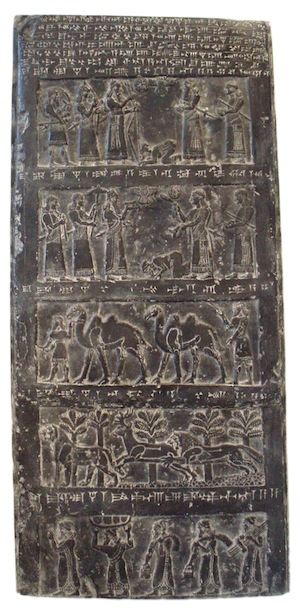Assyrian

Panel from the Black Obelisk of Shalmaneser III
Near Eastern (Assyrian)
replica: from the British Museum, London
gift of: Dr. Gary Hanson, for Dr. Michael Swan, for excellence in graduate teaching supervision
date of the original: c. 825 BC
provenance of the original: Kalhu (Nimrud), Iraq (discovered by Sir Austen Henry Layard in 1846); now in the British Museum, London
description: This is one side of the original obelisk, which stands two metres tall and has four sides, each with 5 picture panels interspersed with cuneiform inscriptions. There is also cuneiform above and below each set of pictures. The inscriptions record the annals of thirty-two years of the reign of the Assyrian king Shalmaneser III (r. 858-824 BC). Most of the illustrations record the tributes brought to Shalmaneser by various vassal kings. This panel: plaster replica; black alabaster original. Height 112 cm, width 55.5 cm, depth 5.5 cm.
The Black Obelisk became famous when scholars realized that it made reference to Jehu, King of the Israelites. who is mentioned in the Old Testament (Kings 19.16; 2 Kings 9-10). A descendant of Shalmaneser III, Shalmaneser V, is mentioned in 2 Kings 17:3 and 18:9. The Black Obelisk also mentions the King Hazael of Damascus who appears in the Old Testament (2 Kings 8:28f; 9:14f).
The top panel of the replica shows Sua, the Gilzanite, bringing tribute to Shalmaneser, who is standing to the left, armed with a bow and arrows and accompanied by an attendant and soldier. Above this scene are the winged sun-disc, divine symbol of the god Assur, king of all of the great gods, and the eight-pointed star, divine symbol of Enlil, creator and father of the gods.
The second panel, which is possibly the most significant, depicts Shalmaneser receiving tribute from Jehu, king of Israel, who is prostrate before the king. Shalmaneser holds a bowl in his raised hand and is sheltered by a parasol held by an attendant.
The tribute of the country of Musri, illustrated on the third panel, consists entirely of animals led or driven by attendants dressed in knee-length garments.
The fourth panel illustrates two lions hunting a stag in a forest, perhaps reminiscent of the countries which Shalmaneser has conquered.
The bottom panel records the tribute of Karparunda of Hattina, brought forth by porters wearing pointed caps.
Translations of the inscriptions describing each scene:
I. Tribute of Sua, the Gilzanite. Silver, gold, lead, copper vessels, staves (staffs) for the hand of the king, horses, camels, whose backs are doubled, I received from him.
II. Tribute of Jehu, son of Omri. Silver, gold, a golden saplu (bowl), a golden vase with pointed bottom, golden goblets, pitchers of gold, tin, staves (staffs) for the hand of the king, puruhtu (javelins?), I received from him.
III. Tribute of the land of Musri. Camels whose backs are doubled, a river ox (hippopotamus), a sakea (rhinoceros), a susu (antelope), elephants, bazîtu (and) uqupu (monkeys), I received from him.
IV. Tribute of Marduk-apal-usur of Suhi. Silver, gold, pitchers of gold, ivory, javelins, buia, brightly colored and linen garments, I received from him.
V. Tribute of Karparunda of Hattina. Silver, gold, lead, copper, copper vessels, ivory, cypress (timbers), I received from him.